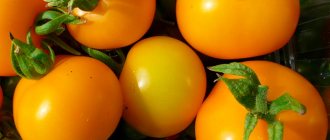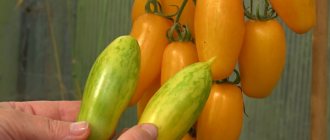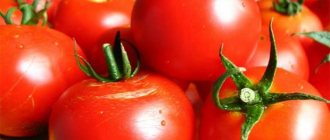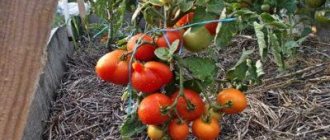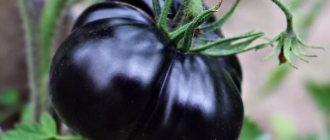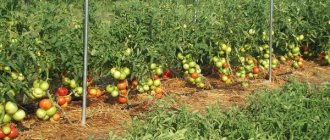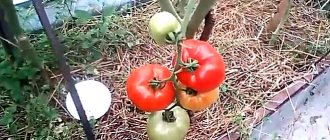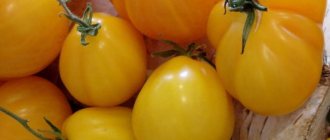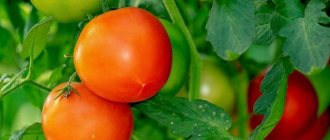Description of tomato varieties for open ground
All varieties are divided into determinate and indeterminate, that is, low and tall (up to 1.5-2 m). Both types are represented in the rating.
Let's get to know each representative better:
- Honey spas is an indeterminate plant that grows up to 1.5 m in height. It got its name because of its pronounced sweet taste. The variety is mid-season - fruits appear 110-117 days after the formation of seedlings. The skin color ranges from orange to red.
- Pink elephant - the name is completely true. The fruits of the plant are really pink and large, weighing from 200 to 1000 g. The vegetable is distinguished by juicy pulp and thin peel, which is easily removed during cooking. This is a mid-season variety that produces a harvest on days 112-116 from the moment of germination.
- Aphrodite F1 - bred by Russian breeders, belongs to the ultra-early varieties, indeterminate, up to 1.5 m high. The plant gives a good harvest - up to 6 kg per bush. Ripe fruits are red in color, with smooth skin and delicately sweet pulp.
- The Amur standard is early, ripens 90 days after picking seedlings in open ground. Loamy and sandy loam soil and chernozem are well suited for its development. The plant is standard, with strong stems and leaves. The height of the bush reaches 50 cm.
- Iceberg is an early ripening variety that allows you to harvest the first harvest on the 85th day from the moment the seedlings appear. The bushes are low - up to 80 cm high. One plant bears up to 4 kg of fruit per season. Ripe tomatoes have thick, red skin.
- Asvon is an ultra-early plant; you can enjoy the first harvest 95 days after the seedlings form. The plant bears fruit for a long time - until the onset of cold weather. Ripe vegetables are distinguished by their regular, round shape, perfectly smooth surface, and good density.
- Washington is an early variety from the determinate group, up to 50 cm high. One bush produces 20-30 tomatoes per season, which grow in clusters. The fruits are round in shape, the skin and pulp are red. Vegetables weigh about 700 g and are distinguished by their presentation and sweet taste.
- Agata is another raceme type, growing on branches of 3-5 pieces. This is one of the shortest varieties of tomatoes for open ground in the TOP, the height of which does not exceed 45 cm. The plant boasts versatility in preparation - suitable for salads, canning, first and second courses.
- Appetizing is a pink variety that ripens in 110-115 days. The plant reaches a height of 100 cm when cultivated in open ground. The weight of the fruit is 300-450 g. Up to 5-6 tomatoes are formed on one brush, and from 1 sq. m you can collect up to 8 kg.
- Roma is a tomato of American origin. It has an oval shape and looks like a plum. The plant is not tall - it extends up to a maximum of 80 cm. 3-10 tomatoes are formed on one brush. The vegetable is characterized by a harmonious combination of sweet taste and light sourness.
The best varieties of tomatoes for greenhouses
What is the climate in the Nizhny Novgorod region
The region is located in the temperate zone. The climate is temperate continental. Winter lasts from October to March. Summer begins on June 4th. Warm weather continues until August 15th. 70 days is not enough for the ripening of a heat-loving berry. It is possible to get a harvest from early varieties when grown through seedlings.
In summer, precipitation falls unevenly: in the north-west it is abundant, in the south-east there are frequent summer droughts. The area is blown by winds. Hurricanes occur every 5–10 years. In the summer season there are thunderstorms with hail. Plants need to be covered with non-woven material.
See also
When to plant seedlings and how to grow cherry tomatoes in open ground and greenhouseRead
The average temperature in July is +19 °C. On other days it rises above +30 °C, in some areas up to +39 °C. To maintain the ability to bear fruit, tomato plantings must be shaded.
The region is characterized by gray forest, swamp, sod-podzolic, podzolic, and chernozem soils. Fertile black soils make up 1/15 of the occupied territory. The rest have high acidity: 4.6–5 pH. For tomatoes to grow actively, they need to be deoxidized.
How we chose
When selecting nominees, the emphasis was placed on the type of plant - determinate or tall, as well as on its yield (how many fruits are obtained from one bush or from 1 sq. m) and taste - whether it is a sweet, sour or neutral ripe vegetable.
During a detailed examination of each applicant, attention was paid to all the nuances:
- The height and abundance of the green part of the plant, the strength of the stems - this determines whether the bush will need to be tied to supports. Under the weight of numerous fruits, it will simply bend to the ground.
- Growing conditions - seedlings or seed method, soil requirements (chernozem, loamy or sandy loam soil), care recommendations: frequency of watering, fertilizing, loosening.
- Resistance to diseases and pests - tomatoes are affected by late blight, nematodes, whitefly, and Alternaria. To combat them, special drugs are used.
- Ripening dates – early, mid-ripening or late. They are indicated in the number of days required for fruit formation from the moment of emergence.
- Taste - the amount of sugar in the pulp. The more it is contained in tomatoes, the sweeter the fruits. Honey vegetables do not always fit into the first and second courses.
- Presentation – shelf life is affected by the juiciness of the pulp and the density of the skin; the harder and less watery it is, the longer it can be stored without consequences. It is these varieties that are preferable for sale because they can withstand transportation.
- Weight, shape, size and color of fruits . There are round, oval and heart-shaped tomatoes in red, pink, orange, black, yellow and even purple.
- Versatility in cooking . In the process of compiling a rating of the best varieties of tomatoes for open ground, we paid attention to the preservation of the taste of tomatoes during the preparation of fresh and winter salads, when canning and adding to first and second courses.
When compiling the rating, Vyborexperta.ru experts looked at the compatibility of all these factors, since very often tasty fruits are not at all marketable and vice versa.
The best soil for plants
The best tall tomatoes for open ground
This is the name for indeterminate varieties up to 1.5-2 m high. Due to their growth, they necessarily require garters to supports. It is beneficial to grow such plants in small areas due to space saving. VyborExpert specialists in the field of gardening studied the available varieties and, by analyzing their yield, disease resistance, and taste, selected the 2 best options for this section of the rating.
Honey saved
The “Honey Spas” tomato is indeterminate and grows up to 1.5 m in height; it requires staking. In the South and Moscow region, the plant can be grown in open ground, and in central Russia, planting in greenhouses is recommended. It is mid-season - 110-117 days pass from the emergence of seedlings to harvest.
The fruits of Honey Spas are large, weighing 200-600 g. The shape of the tomatoes is heart-shaped, the skin is not thick and soft, and orange in color. The pulp is juicy and practically without seeds, so the vegetable is excellent for preparing fresh salads. But the juice that comes out of it is not very tasty. The harvest is stored for a long time and does not lose its taste - it remains sweet and tender.
Advantages
- 1 bush gives up to 5 kg;
- Disease resistance;
- Does not rot in the beds;
- Marketable condition;
- Nice smell.
Flaws
- Quite a big core.
According to reviews, the tomato is moderately sweet and is suitable both for consumption in its pure form and for adding to various dishes - pizza, stew, etc.
Pink Elephant
This variety of tomatoes is called salad because of its sweet-honey taste, thin peel and juicy pulp. Their “skin” is quite dense and the tomatoes are well transported, maintaining their presentation for a long time. This is not the best option for canning and preparing juice due to the considerable size and weight of the fruit - 200-300 g, some specimens grow up to 800-1000 g.
Each bush produces up to 7-8 tomatoes, and the yield per 1 sq. m is about 6-8 kg. That is, no more than 3 kg is obtained from one bush, and this is in the case of high-level agricultural technology. Fruiting is extended over time and continues until autumn. Technical ripeness occurs 112-116 days after emergence. The plant reaches 160-170 cm in height, however, due to its power, large leaves and thick shoots, it needs a garter.
Advantages
- Does not crack during droughts;
- Low susceptibility to disease;
- Sweet;
- Versatile in preparation;
- Grows well in various types of soil.
Flaws
- Poorly pollinated in a greenhouse;
- Demanding about fertilizing.
The Pink Elephant has a shiny skin that retains its appearance for a long time. Therefore, this variety is well suited for growing for sale.
Tomatoes: how to grow a good harvest
Tomatoes are perhaps one of the most favorite vegetables among summer residents. But in short, cool summer conditions, tomatoes can be capricious and not produce full harvests. Therefore, it is important to provide them with comfortable conditions.
There are currently about 3,000 varieties of tomatoes in the State Register of Breeding Achievements, and their number is growing every year. They are of different shapes and sizes and for different purposes - salad, pickling, cherry.
Different ripening periods and different heights. And all this leaves an imprint on the characteristics of care. Each group of varieties requires its own approach.
Let's find out what needs to be done to get a good harvest of sweet and aromatic fruits.
Growing tomatoes
Tomatoes are heat-loving plants, so they are usually grown through seedlings. In the southern regions, where summers are hot and long, they can be safely planted in open ground. In the northern regions, it is better to grow tomatoes in greenhouses - this guarantees a good harvest. Moreover, you need to choose early or mid-ripening varieties - they will definitely have time to give out their full potential.
The area for tomatoes should be sunny - they love an abundance of light. The soil is fertile.
Tomato seedlings
Planting tomatoes
In the middle zone, tomato seeds are sown for seedlings in 3 periods:
- late varieties - at the end of March;
- mid-season varieties - in early April;
- early varieties - in mid-April.
In the southern regions, as well as in the north, in greenhouses, early and ultra-early varieties can be sown directly on the beds, without seedlings - this is done at the end of April. With this method of sowing, tomatoes ripen a little later, literally by a week or two, but you don’t have to bother with seedlings.
Seeds for seedlings or in open ground are sown to a depth of 1–2 cm.
There is another way to sow tomatoes - before winter. In this case, it is not the seeds that are sown in open ground, but the whole fruit. This is done in early November. In winter, beds with tomatoes are mulched with sawdust or peat with a layer of 10 cm.
In the spring, in mid-April, the mulch is removed. And usually at the end of April sprouts appear - they sprout in a bunch, since all the seeds were in one tomato.
The seedlings will need to be covered with non-fabric, and when they have a pair of true leaves, they will need to be planted into the beds.
With the classic growing method, tomato seedlings are planted in open ground in early May - under cover with film or non-woven fabric. Or in early June, when the danger of returning spring frosts has passed - in this case, shelter will not be needed.
You can start planting tomatoes in the greenhouse from mid-April.
When planting seedlings, it is useful to bury them in the soil until the first true leaves - then additional roots are formed on the shoot, which will help the plants better extract nutrients and water from the soil.
Caring for tomatoes in open ground
Caring for tomatoes includes 3 important activities.
Watering
Tomatoes love abundant watering, but not all summer. Water them as follows:
- from the moment of planting in open ground or a greenhouse until the beginning of fruit formation - once a week, 1 liter per plant;
- during fruit filling - every 5 days, 3 liters per plant.
Tomatoes should be watered strictly at the root so that water does not get on the leaves - this will increase the risk of developing diseases. And it’s better to do this in the first half of the day, so that by the evening, when it gets cool, the surface of the soil will dry out slightly - this again reduces the possibility of the pathogen reproducing.
When the fruits begin to ripen, stop watering, otherwise the tomatoes will begin to crack.
If it is not possible to water the tomatoes every 5 days (this problem arises for weekend gardeners), the beds should be mulched and it is best with hay - they will retain moisture in the soil longer and will protect the plants from fungal diseases, since hay bacillus develops in the hay, which suppresses development of pathogens.
Feeding
There are different schemes for feeding tomatoes, but, in fact, they only need 3 feedings over the summer:
- when planting in a hole - half a bucket of humus or rotted compost;
- during fruit growth - 5 teaspoons of ammonium nitrate and 4 teaspoons of potassium sulfate per 10 liters of water, watering rate - 3 liters per plant;
- 20 days after the second - the same fertilizers in the same doses as in the second feeding.
Bush formation
It all depends on the type of growth of tomatoes, and according to this criterion they are divided into 3 groups:
- superdeterminant (short);
- determinant (with limited growth);
- indeterminate (with unlimited growth).
Superdeterminant
tomatoes are the shortest growing ones, they lay only 3 flower clusters on the main shoot and produce very few stepsons, so in principle they don’t need to be planted.
But it’s still better not to let the plants take their course - extra shoots will take away nutrients from the bush, and the fruits on them may not have time to ripen if the summer is short.
Therefore, it is better to leave 2 shoots on each plant: the main and the lowest stepson (for open ground) or 3 shoots: the main and two lower stepsons (option for greenhouses).
Determinant
tomatoes have an average height and are characterized by limited growth - after they have formed 3-6 fruit clusters, they stop growing.
Such tomatoes are usually formed in two ways - this also depends on where they grow: in open ground or in a greenhouse. In garden beds they are usually formed into one shoot - only the main one is left.
On the side crops, during the short summer, the crop may not ripen. And in greenhouses you can leave 3 shoots - the main one and two lower stepsons.
Indeterminate
tomatoes are the tallest, they can reach a height of 1.5 - 2 m and would grow indefinitely if frosts did not kill them in the fall. Another feature of these varieties is that they plant the first flower clusters very high, only above the 10th - 12th leaf.
Therefore, they are formed exclusively into one shoot - the fruits on the stepsons will not have time to ripen even in greenhouses. In addition, for such tomatoes it is necessary to normalize the number of fruit clusters: in the open ground only 5 are left, in the greenhouse - 7. 1 leaf is left above the topmost one, and the top is cut off.
And throughout the summer you need to cut out all the stepsons.
Harvesting tomatoes
Tomatoes on the bushes ripen unevenly - first the tomatoes on the lower clusters ripen, then higher and higher. Therefore, they need to be removed gradually as they mature. If you plan to transport the rafts somewhere, then it is better to remove them a little unripe - this way they will not get wrinkled on the road. If tomatoes are intended to be eaten right away or for juice, then they must be harvested at full ripeness.
It is advisable to harvest the entire crop before the air temperature begins to drop below +7 °C - the fruits stop ripening in such weather.
It is better to harvest in the morning, after the dew has disappeared - at this time they are the most juicy and fragrant.
Rules for storing tomatoes
Tomatoes can lie in the apartment for some time, depending on the degree of ripeness. There are four in total:
- dairy:
the fruits have reached their typical size, but have not yet begun to turn brown - they ripen in 10–17 days; - blanzhevaya:
the fruits begin to lighten, their tops are barely colored - they ripen in 7–10 days; - technical:
the fruits are brown and begin to acquire their typical color for the variety - these ripen for 5–6 days; - biological:
the fruits are fully ripe and have acquired their typical color.
Knowing these features of fruit ripening, you can guess the storage time, for example, bring fruits from the garden in milky ripeness and get ripe tomatoes in 2 weeks.
Ripe and brown tomatoes can be stored in the refrigerator. Shelf life depends on temperature:
- at +1 °C – 2–4 weeks;
- at +4...+6 °C – about 10 days.
Is it possible to preserve tomatoes for a long time, for example, until the New Year? It is possible if you plant special varieties and hybrids.
– Until the New Year, the following hybrids can be stored right in the apartment: Blues F1, Viscount F1, Giraffe, Intuition F1, Cartouche F1, Hummingbird F1, Lounger F1, Ostrich F1
and varieties:
Long Keeper, Master, New Year, Khutorskoy salting,
” says
agronomist-breeder Svetlana Mikhailova.
They do not always have excellent taste, but they will be very appropriate for fresh salads - they are homegrown, from the garden, and environmentally friendly! So it’s quite possible to plant a couple of bushes of such tomatoes.
Where to buy seeds of rare varieties of tomatoes
You can buy seeds of collectible varieties of tomatoes, as well as rare plants, in the online store Chudogryadka.rf (https://chudogryadka.ru/) - just follow the link to place your order.
Delivery by mail within Russia is free!
Alexey Volodikhin
, agronomist
Source: https://zen.yandex.ru/media/id/5aee9e41ad0f2291ff29661e/pomidory-kak-vyrastit-horoshii-urojai-5ef31211ddb6bd0b21efab92
The best early varieties of tomatoes for open ground
These varieties include tomatoes that ripen within 85-100 days from the moment the seedlings appear. They are resistant to disease and allow you to harvest in early to mid-July. Early varieties of tomatoes for open ground include the options described below.
Aphrodite F1
The variety comes from Russia from the ultra-early group. The harvest ripens within 90-95 days after planting the seedlings. The fruits will ripen “together”, at approximately the same time. This simplifies the process of preparing preserves for the winter. The maximum height of the plant is 1.5 m, so it is recommended to install supports immediately after the ovaries form. The plant is thermophilic and requires fertilizing. With good agricultural technology, tomatoes grow weighing up to 110 g.
Aphrodite F1 is not very afraid of fungal infection, which increases the yield. One bush yields up to 5-6 kg. The ripe fruits are red in color, have a perfectly smooth surface and thin skin that is easy to peel. Due to their small size - about 4 cm in diameter, they are ideal for canning in jars. The vegetable has a sweet, pleasant taste, which, along with its long shelf life (at least a week), was appreciated by sellers.
Advantages
- Small core;
- Not hard peel;
- Juicy pulp;
- Soft seeds;
- Ripens inside.
Flaws
- It is not easy to grow seedlings;
- Not the cheapest seeds.
As reviews show, tomatoes are suitable for whole-fruit canning, making lecho, juice, adjika, ketchup, sauce, for drying and drying.
Amur standard
One of the earliest varieties, producing fruits already 90 days after planting in open ground. The plant is determinate, up to 50 cm high. The vegetable crop thrives in black soil, loamy and sandy loam soil. The bush has strong stems and leaves. The Amur standard does not require pinching, that is, it belongs to the standard varieties. It develops at low temperatures, so it can be grown even in central Russia.
The Amur standard does not die from drought, although it is not indifferent to moisture. In the absence of rain, the fruits do not crack and do not lose their sweet taste. A bush can produce up to 10 tomatoes weighing about 120 g. The tomatoes are round in shape, slightly flattened at the top. The skin and flesh are bright red. There are some seeds inside (about 5 pieces), but they are quite large. The vegetable contains a lot of juice. The yield is 4.8 kg per 1 sq. m.
Advantages
- Fast fruit set;
- Not affected by late blight;
- Not afraid of verticillium;
- Productivity doubles with regular feeding;
- Can be grown without seedlings.
Flaws
- In terms of cold resistance, it is inferior to other varieties in the rating.
As they say in reviews, the fruits can be used for pickling, making tomato juice and fresh salads. It is in this form that they are most useful due to the preservation of choline, which strengthens the immune system and restores normal liver function.
What does a tomato like?
Tomato loves warmth and bright light. Slight shading causes growth to stop. No ovaries are formed, the bush begins to actively grow green mass. The gardener gets grass, not fruits.
Tomato prefers soils that are moisture-permeable, breathable, and light. Clayey ones require sanding, sandy ones require claying. On peat bogs, both components should be applied.
Factors of active growth and fruiting of the plant:
- temperature during germination – 23–25 degrees Celsius;
- growth and development temperature – 25–28 degrees Celsius;
- daylight hours – 16–18 hours;
- optimal air humidity – 60%, soil – 70%;
- soil acidity – 6 pH.
Ideal soils for tomatoes are black soils. On others, the acidity should be changed. To reduce it, add ash and lime.
When the temperature drops to 10 °C, the bush stops growing. Cooling down to 15 ° C - the ovaries crumble. Heat of 30 °C and above leads to sterilization of flower pollen.
Before flowering, the plant actively consumes nitrogen and phosphorus. Then the need for potassium and phosphorus increases.
The best productive tomato varieties for open ground
Productive varieties of tomatoes for open ground are considered to be those that produce at least 3 kg per bush. The number of fruits is influenced by the weather, resistance to diseases and pests, the level of agricultural technology, and the type of soil in which the plant is cultivated. The most generous in this regard are 3 varieties, which will be discussed below.
Iceberg
An early plant, ripening within 85-90 days from the moment of germination. A bush with strong stems, determinate, up to 80 cm high. Due to limited growth, vegetables ripen faster. Due to the large number of fruits (up to 4 kg), it is recommended to tie it to supports. Ripe tomatoes have a rich red color and thick skin, and therefore are suitable for canning.
The formation of a bush and pinching of stems is not necessary for the variety, which is also unpretentious to cultivation conditions. The plant tolerates temperature changes normally and reacts calmly to short-term frosts. Iceberg fruits retain their presentation for several days due to the low water content of the pulp. They are moderately sweet and smell nice.
Advantages
- 1 bush gives up to 4 kg;
- Wide scope of application;
- Small, neat sizes;
- Weight up to 200 g;
- Due to its short stature, it can be grown in small areas.
Flaws
- Susceptibility to diseases and pests - mole crickets, nematodes, wireworms;
- A large number of seeds.
Ripe fruits are used in vegetable salads and slices, for twists, making adjika and ketchup.
Asvon
Another ultra-early tomato, ripening within 95-100 days. The growing season lasts until the onset of cold weather. The plant is compact and does not take up much space in the garden; it grows well. Dense vegetative mass prevents sunburn of tomatoes. The fruit sets well, but for this to happen it must be warm outside. They have dense and fleshy flesh of a rich red color. There is no white rod inside.
The vegetable is round in shape, with a uniform, easy to peel skin. Its high density allows tomatoes to maintain their integrity during preservation. Fruit weight is from 70 to 95 g. The variety is characterized by high yield - about 100 tomatoes per bush per season. They do not crumble during droughts and do not lose their taste.
Advantages
- Glossy skin;
- Marketable condition;
- Tolerates transportation well;
- Unpretentiousness in cultivation;
- Heat resistance.
Flaws
- During fruiting, tomatoes become smaller in size;
The tomato looks great when pickled, so rolled up jars are good for sale.
Washington
An early variety of tomatoes for open ground “Washington”, the fruits of which ripen 95-100 days after germination. This is a determinate variety up to 50 cm high, which does not require pinching or pinching. But tying it to a support may be necessary. Ripe vegetables are round, red in color, weigh about 700 g. They grow in clusters, like grapes. On one bush at a time it will sing up to 20-30 pieces.
The vegetable is round in shape and slightly flattened at the top. The skin is smooth and shiny, which gives the tomato a marketable appearance and increases sales. The variety’s popularity is also due to its excellent taste – the flesh is sweet, moderately dense and juicy. Therefore, it can be used to prepare ketchup, adjika, juice, puree, winter and summer salads.
Advantages
- Easy to care for;
- Good acclimatization;
- Not afraid of late blight;
- Not attacked by insects due to early ripening;
- Long shelf life.
This is an average variety in terms of yield - from 1 sq. m yields up to 7 kg of tomatoes. The better the agricultural technology, the more fruits.
Flaws
- Not detected.
The best sweet varieties of tomatoes for open ground
Tomatoes can be sour, neutral, sweet, honey. This section of the rating contains options that are optimal in terms of sugar content, tasty both fresh and thermally processed. We are talking about 3 representatives.
Agatha
...I have been growing this variety for several years now, and every year the harvest volume does not decrease. To increase the number of ripe fruits, you need to follow the correct agricultural techniques - feed and water the plants, loosen the soil...
Expert opinion
The “Agatha” variety is valued for its smooth, even and neat fruits, as if one to one. They look great on the table as slices and perform well in salads and preserves, in first and second courses. On average, the weight of a tomato is 110 g. Their shape is round, the color ranges from orange to dark red, depending on the time of harvest. The vegetables taste sweet and pleasant.
Agatha grows in clusters of 3-5 pieces. Usually it contains no more than 5.5% dry matter, so the crop is stored fresh for a long time and tolerates transportation well. In this regard, the plant is often grown for the purpose of further sale. The height of the bush does not exceed 35-45 cm, that is, it is determinant. The bush is easy to care for and does not require frequent watering or fertilizing.
Advantages
- Friendly maturation;
- Versatility of use;
- Sweet taste;
- Ripening time – from 95 to 110 days;
- Early harvest.
Flaws
- Average disease resistance;
- Gives no more than 4 kg per bush.
Thanks to its dense peel and pulp, it is a good option for filling with fillings - cheese, mushrooms, meat.
Appetizing
The variety of tomatoes for open ground “Appetizing” is low-growing and pink. The plant is determinate - limited to a height of 100 cm in open ground and 170 cm in greenhouses. It ripens within 110-115 days from the moment the seedlings appear. The bushes quickly grow green mass and are overloaded with fruits - each of them grows 5-6 pieces. on one hand. The vegetable is quite large and heavy, weighing up to 450 g. The size can be increased by pinching. To withstand such a load, tying is required.
The appetizing one calmly tolerates cool summers, and the yield does not decrease as a result. Usually it is at the level of 8 kg per 1 sq. m. Sweet taste, not rough peel and juicy, sugary pulp make it an ideal candidate for preparing salads. The vegetable is spherical in shape, not very smooth. Initially, breeders developed the variety for fresh consumption, but it was perfect for making ketchup, sauce, and paste.
Advantages
- Tasty even when unripe (green);
- Not hard;
- When cutting, almost no juice comes out;
- Fresh, pleasant smell;
- Fast maturation.
Flaws
- The fruits are greenish at the top even when ripe.
Gardeners would like to improve the transportability of ripened tomatoes. Also, many people do not like the branching nature of the bushes, which makes it impossible to fit them into a small area.
Roma
A foreign representative, bred in America and distributed in Europe and Australia. The variety is not included in the State Register of Russia, but is recommended for cultivation both in open and closed ground. Due to its frost resistance, it can be cultivated throughout the country. Roma is classified as “cream” due to the same elongated shape, so it can easily be preserved in jars.
The plant is determinate, up to 80 cm high. Tomatoes are formed in clusters of 3-10 pieces. weighing up to 80 g. Unripened tomatoes successfully ripen indoors, and ready-made tomatoes tolerate storage well. Fruiting begins 105-125 days after germination and occurs in 3 waves. The vegetable is tasty, combines sourness and sweetness due to the high sugar content.
Advantages
- Resistance to Fusarium and Verticillium wilt;
- Decent yield - from 8 to 12 kg per 1 sq. m;
- Not prone to rot;
- Resistance to cracking;
- Versatility in cooking.
Flaws
- It is grown only through seedlings.
In reviews, gardeners point out the excellent keeping quality and transportability of tomatoes. This is facilitated by its light weight and thick skin.
Middle and late greenhouse varieties
King of Kings
- growing season 120-135 days;
- plant growth – 1.45-1.85 m;
- tomato weight – 500-1000 g;
- yield per bush – 5.5 kg.
A real giant has good resistance to late blight and rot. The size of the tomato is supported by its excellent taste, which justifies the name.
King of Kings
Bobcat
- growing season 120-130 days;
- plant height – 50-70 cm (sometimes the bush reaches 1.2 m);
- tomato weight – 180-240 g;
- yield over 4 kg.
A hybrid of Dutch origin was registered in Russia in 2008. The tomato is recommended for cultivation in the middle zone. In the northern regions it is grown under cover.
The main advantages of the Bobcat variety: it easily tolerates drought, is resistant to most diseases of nightshade crops, and produces a consistently good harvest. The disadvantage is the ripening period (late ripening), so it cannot be grown throughout the entire territory of the Russian Federation.
Bobcat tomatoes
Rocket
- growing season 115-125 days;
- plant height – 50-70 cm;
- tomato weight – 40-60 g;
- yield - 5-6.5 kg per bush.
The tall variety Raketa was bred by domestic breeders and was registered in 1999. The best harvest results were observed in the southern regions, but thanks to proper agricultural technology, it is possible to harvest a record number of fruits in the middle zone.
The plant is resistant to rot and late blight; its short stature allows the vegetable to be cultivated in open beds, in greenhouses and even on the balcony. The crop is demanding in terms of watering and fertilizing; as a result of poor agricultural practices, tomatoes can crack.
French grape
- medium-late ripening;
- plant height – 1-1.5 m;
- tomato weight – 80-100 g;
- yield - 3.5-4.7 kg per bush.
The advantages of the French grape variety are its unpretentiousness to agricultural technology, the excellent taste of the fruit, and the beautiful appearance of the tomatoes. The harvest is well preserved and transported due to its dense peel. The disadvantage is the late ripening of the fruits; the climate of some regions does not allow ripe tomatoes to be removed from the garden at the end of the season.
Abakansky
- medium-late ripening period (115-125 days);
- plant height – 1.5 m;
- tomato weight – 250-300 g;
- yield per bush – 5 kg.
The appearance and taste of the vegetable are excellent. The culture reacts positively to mineral supplements and is resistant to fungi. The disadvantages are: a weak tomato stem that cannot support large fruits (a garter is required), requirements for watering and lighting.
A large assortment of varieties makes it possible to choose tomato options for summer salads and winter preparations.
Gardeners prefer growing tomatoes in open ground. The best varieties allow you to get the promised harvest without loss. Tomatoes must be strong and disease resistant. It is necessary to collect ripe berries before late blight damage occurs.
Summer residents of the Nizhny Novgorod region should take a responsible approach to the choice of varieties and hybrids. Tomatoes from the south of Russia ripen in open ground. Other regions cannot boast of such a combination of temperature, number of sunny days and precipitation. People have to maneuver.
But choosing the right seeds does not guarantee a good harvest. Tomato is picky about soil structure and acidity. Structuring measures should be carried out.
Gardeners in the Nizhny Novgorod region need to carry out significant preparatory work before planting.
Which variety of tomatoes is best for open ground?
For the southern regions, absolutely all varieties of tomatoes are well suited for open ground tomatoes, but in the northern regions, early ripening ones that do not have time to catch frosts do best. They and varieties with medium ripening periods can be safely planted in central Russia. Vegetables that are not very fleshy and juicy are suitable for preservation, while juices and fresh salads, on the contrary, are prepared from soft fruits.
The choice of a particular tomato is also influenced by the type of soil, the purpose of growing tomatoes and their area of application.
- Honey Spas is well suited for heat treatment (in pizza and soups, in main courses).
- The juicy and soft Pink Elephant has proven itself to be excellent in summer salads.
- For the purpose of conservation, it is recommended to grow Aphrodite F1 with neat and dense fruits.
- Those who want to cultivate vegetables without first harvesting seedlings should pay attention to the Amur standard.
- Due to its good yield and keeping quality, the Iceberg tomato is planted for sale.
- If you want to enjoy tomatoes until the cold weather, Asvon is a good choice.
- “Washington” is recognized as universal in terms of preparation; it is equally tasty both raw and thermally processed.
- For beginners who have just taken up the cultivation of this vegetable crop, it would not be a mistake to take a closer look at Agatha.
- Another salad variety that also works well in jars is the “Appetizing” variety.
- Those who love sweet and sour tomatoes will be pleased with the Roma variety.
Before you choose which variety of tomatoes to buy for open ground, you should decide on the goals and conditions of their cultivation.
